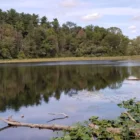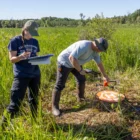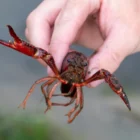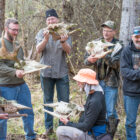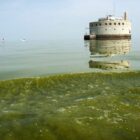Known as the Golden Rose Restaurant and then Country House Catering is now the family-owned and revamped Taste Coffee Company.
Business & Economy
Forty years on, future of contaminant plume under Ann Arbor still murky
|
CONTAMINATED PLUME: Gelman Sciences manufactured medical filters for decades, but dioxane from the Scio Township plant leaked into Ann Arbor’s groundwater, creating a plume of contamination more than 4 miles long. Gelman had been dumping the chemical since 1966, and 40 years after its discovery the plume is larger than ever. By Elinor Eppeson. FOR ALL POINTS.
Education
Researchers use drones to find elusive Michigan rattlesnake
|
DRONES & SNAKES: Faculty and student researchers from Grand Valley State University are using a drone-mounted camera to locate the rare and secretive eastern massasauga rattlesnake, Michigan’s only venomous snake. We go into the field with them near Hastings to see how it’s done. By Ruth Thorton. FOR ALL POINTS.
Agriculture
Michigan trying new approaches against invasive crayfish
|
INVASIVE CRAYFISH: – Researchers are exploring new techniques to remove an invasive crayfish from Michigan waters. The DNR has been fighting an invasion of red swamp crayfish since they first appeared in the state in 2017 but aggressive attempts to trap and remove the crustacean haven’t worked. By Elinor Epperson. FOR ALL POINTS.
Education
Moose lessons: What they can teach us about human aging
|
AGING MOOSE: Getting old can be rough. Osteoporosis. Osteoarthritis. Periodontitis – a trio of chronic diseases that make bones fragile, make joints degenerate and make teeth become loose. That triple-whammy also besets moose, say Michigan Technological University and Duke University researchers who’ve studied the bones of 180 moose that died of natural causes in Isle Royale National Park. By Eric Freedman. FOR ALL POINTS.
Environment
Experts predict moderate Lake Erie toxic algae bloom
|
LAKE ERIE ALGAL BLOOM: Lake Erie’s annual algae bloom has begun to form weeks ahead of schedule off the coast of southeast Michigan, but scientists say they expect only a moderate bloom this year. We hear from a National Oceanic and Atmospheric Administration expert. By Gabrielle Nelson. FOR ALL POINTS.
Arts & Entertainment
Officials mull more access for e-bikes on state trails
|
E-BIKES: Officials are considering a controversial proposal to allow increasingly popular electric bicycles to use more state trails. We hear from the League of Michigan Bicyclists and the DNR. By Gabrielle Nelson. FOR ALL POINTS.
Construction & Development
Dam removal could improve environment, recreation and storm protection
|
DAM REMOVAL: Removal of a 148-year-old dam on the Huron River in Ypsilanti could improve fish habitat, create more green space for recreation and avert the possibility of a damaging dam failure, removal advocates say. But some area residents prefer to have the dam rehabilitated to produce hydropower and preserve its heritage, including the site of an historic paper mill. The Huron River Watershed Council, a city council member and a dam safety expert explain the proposal. DNR and DEGLE support its removal. By Elinor Epperson. FOR ALL POINTS.
Business & Economy
Historic Preservation Tax Credit seeks $100 million to provide ‘more equitable’ restoration across Michigan
|
The Michigan Historic Preservation tax credit, signed into law in 2020, currently allows renovators of historic buildings across the state to apply to receive a portion of a $5 million pool of tax credits. But now, the Michigan Historic Preservation Network (MHPN) says that Michigan’s rehabilitation needs are 20 times that amount.
Representative Joey Andrews (D-38) sponsored House Bill 54390, a resolution to expand the Michigan State Historic Preservation Tax Credits pool from $5 million to $100 million.
Business & Economy
Watershed councils collaborate to change infrastructure from gray to green
|
WATERSHEDS: Watershed councils covering the Huron, Rouge and Clinton rivers have created the Rain Catchers Collective to help more residents and municipalities build green infrastructure. By Elinor Epperson. FOR ALL POINTS.
Construction & Development
Dams may power a stop harmful algal blooms in urban lakes, expert says
|
DAMS & BLOOMS: Like clockwork, Ford Lake and its downstream neighbor, Belleville Lake, turn bright green every summer due to harmful algal blooms. The lakes, near Ypsilanti, have struggled for decades with phosphorus pollution that spurs algae growth. The quest for a solution is familiar to urban lake communities across the Great Lakes region. Area residents, a U-M researcher and an Ann Arbor public works official discuss. By Elinor Epperson and Daniel Schoenherr. FOR ALL POINTS.




